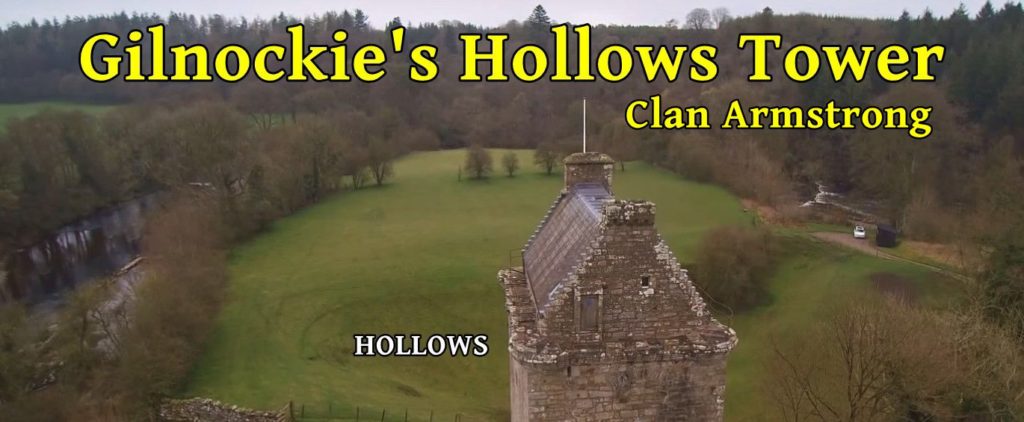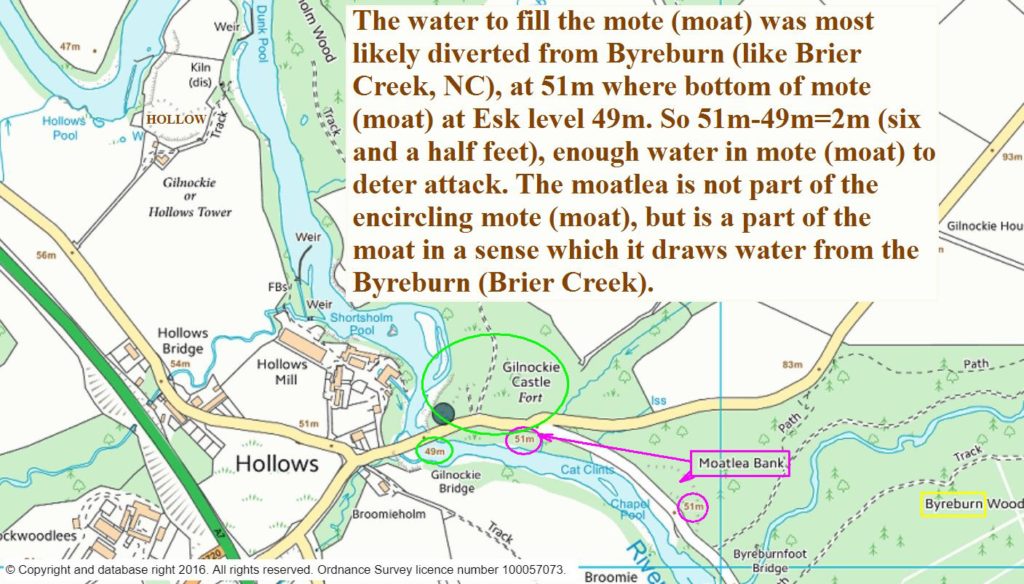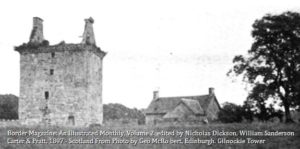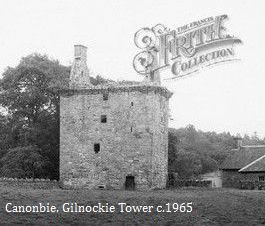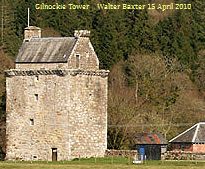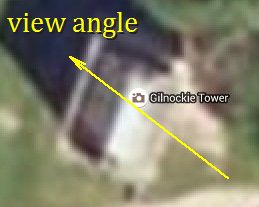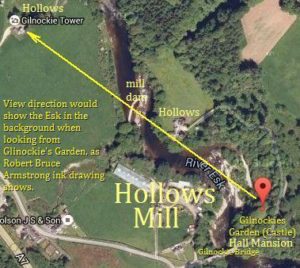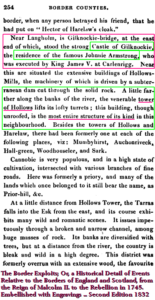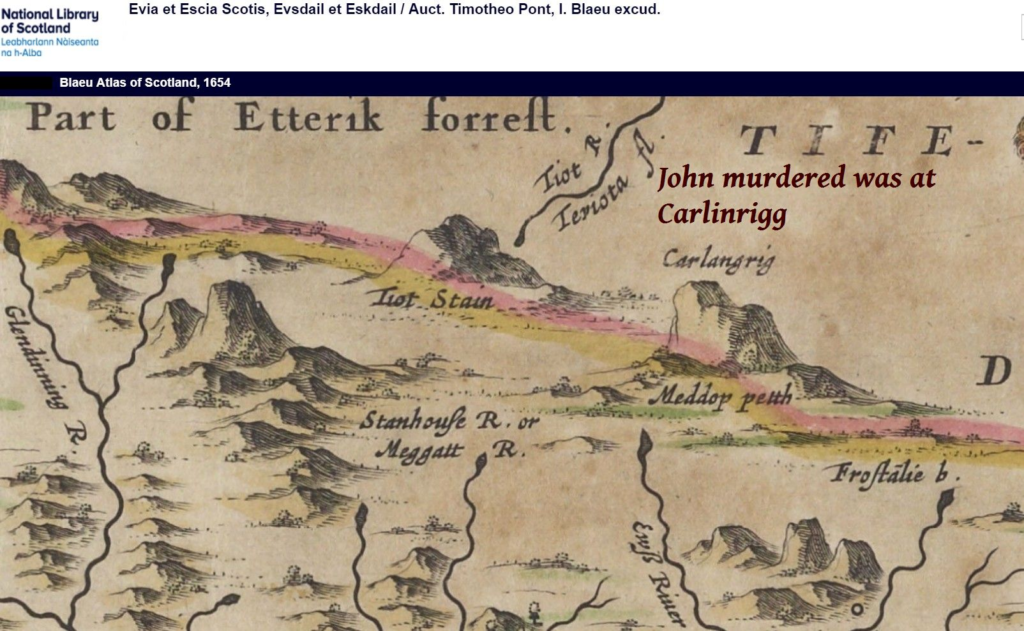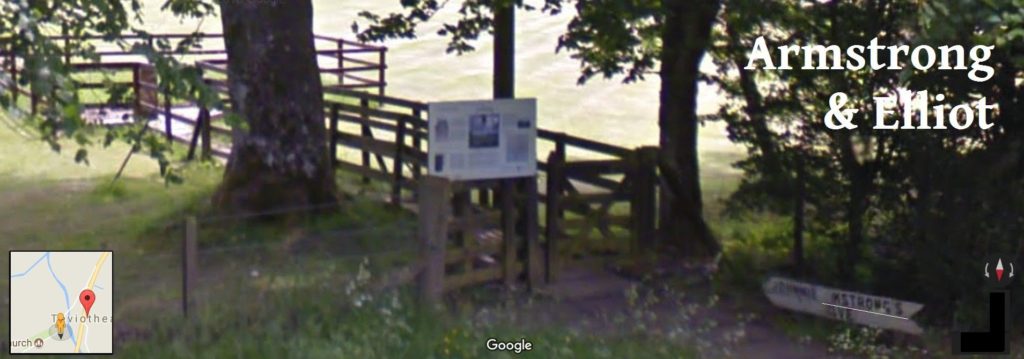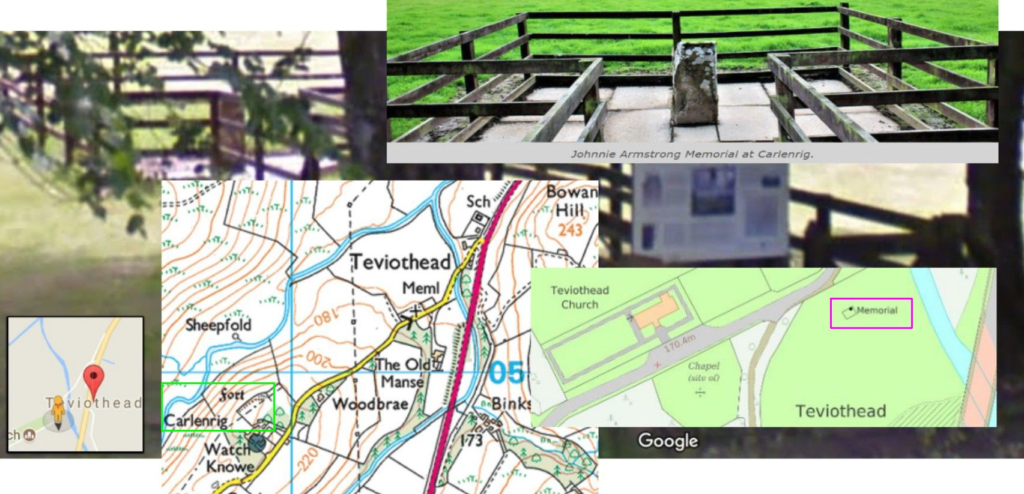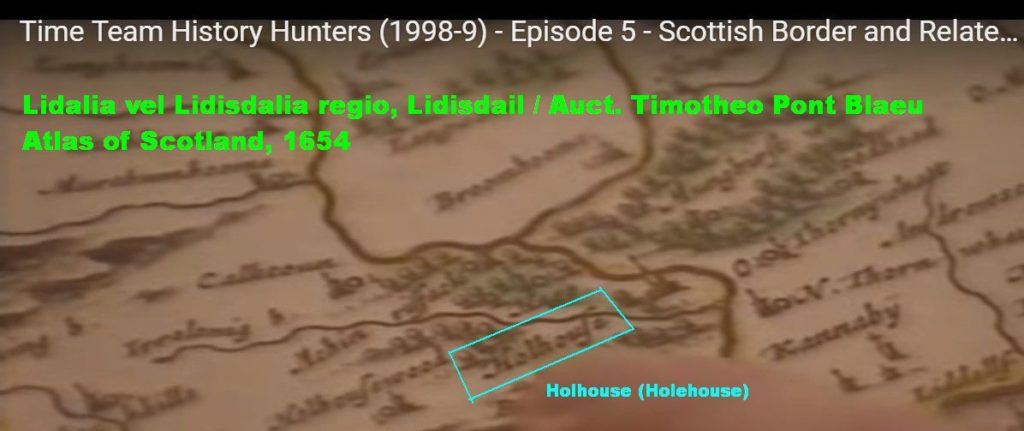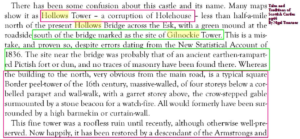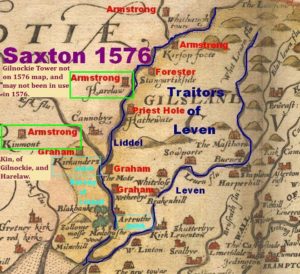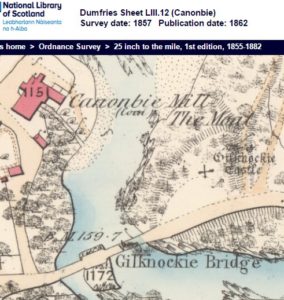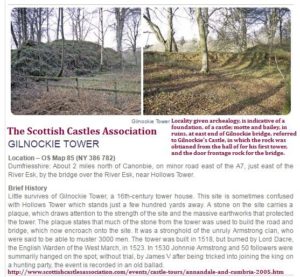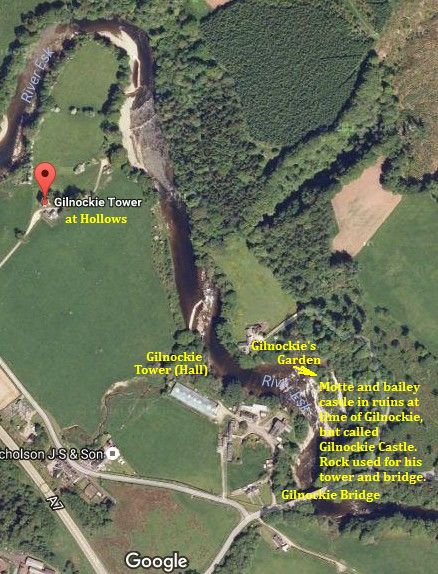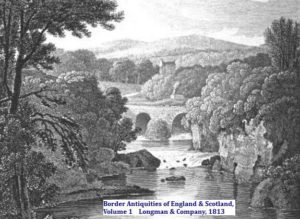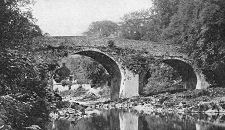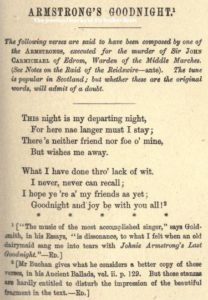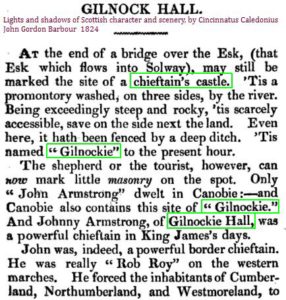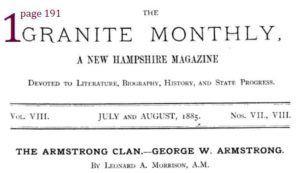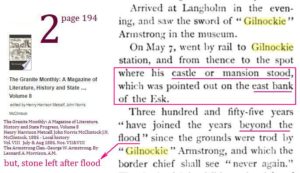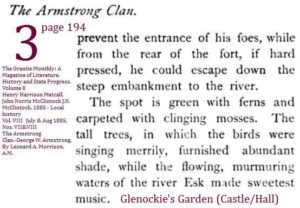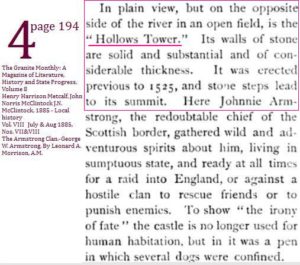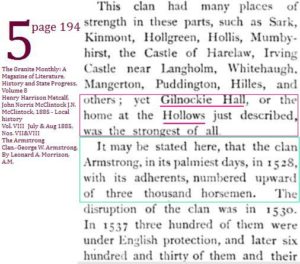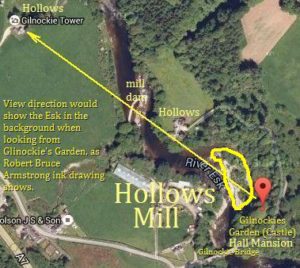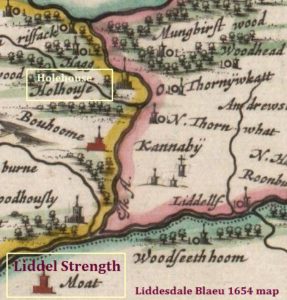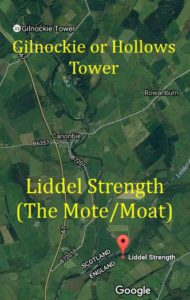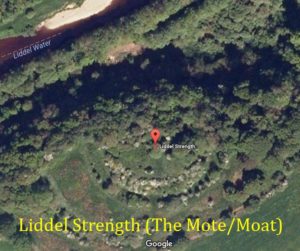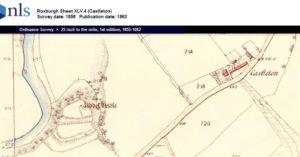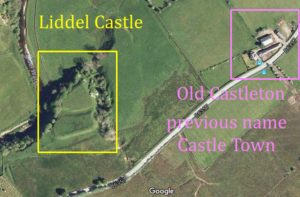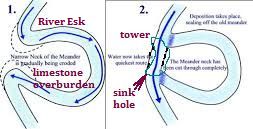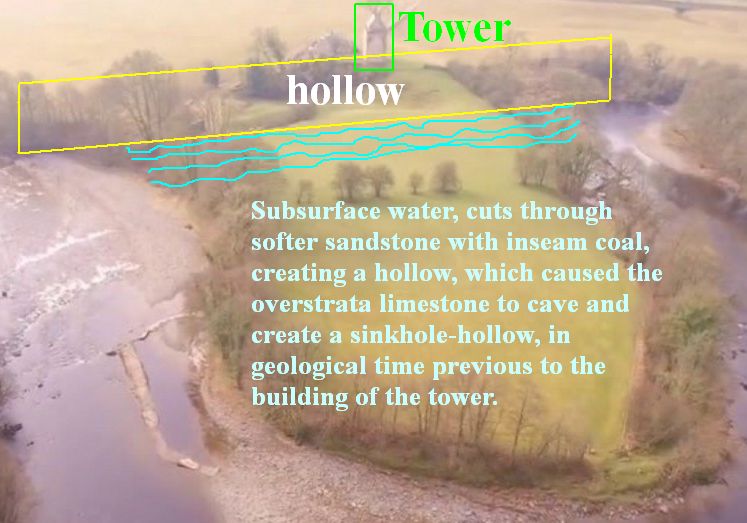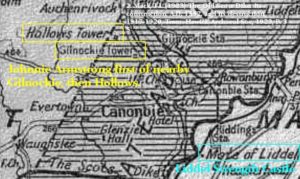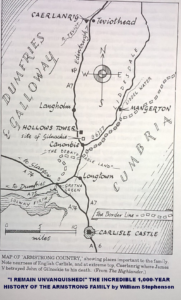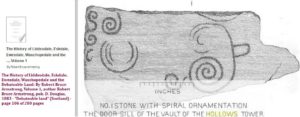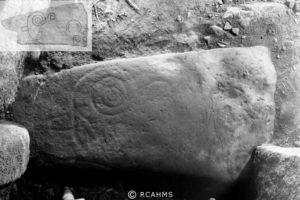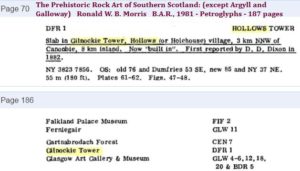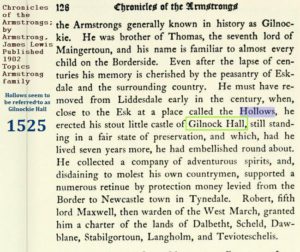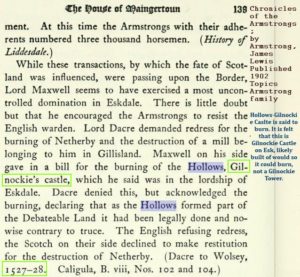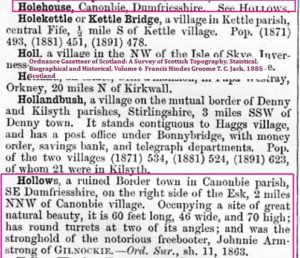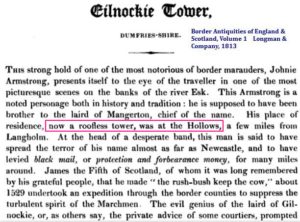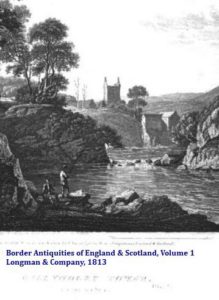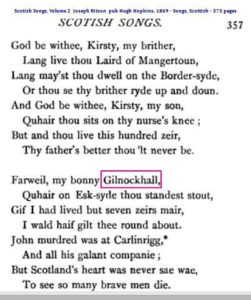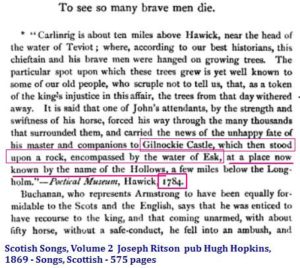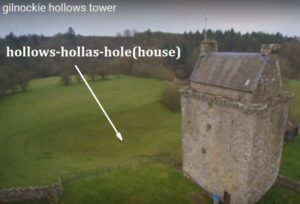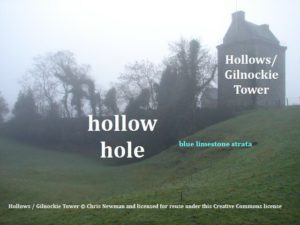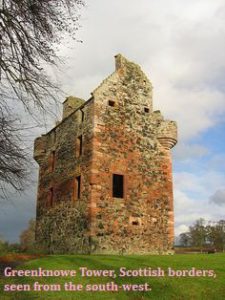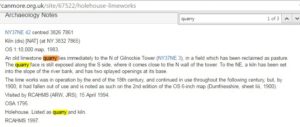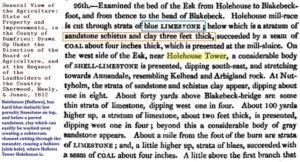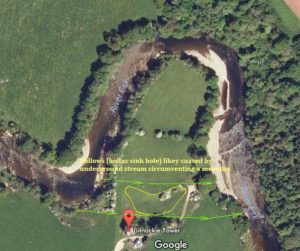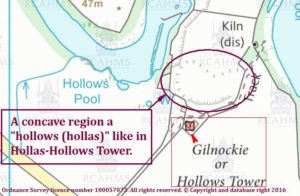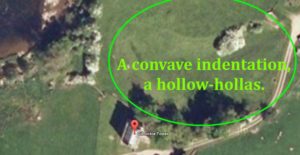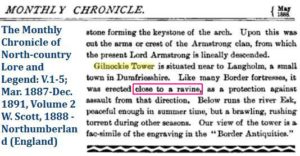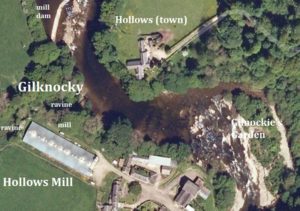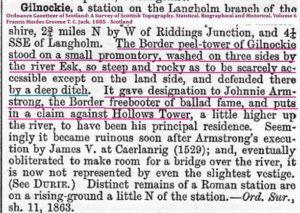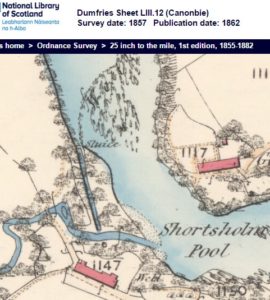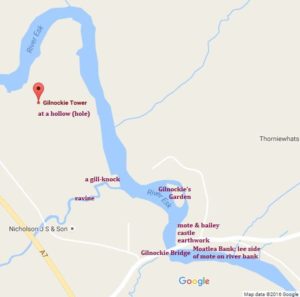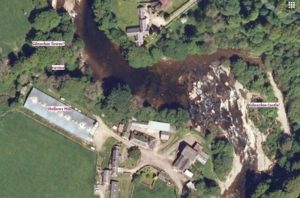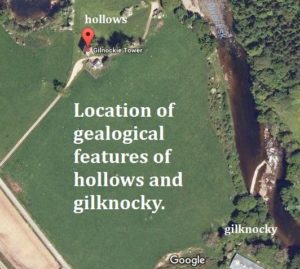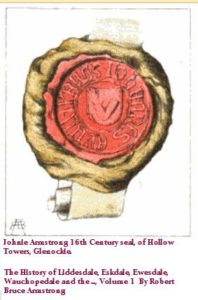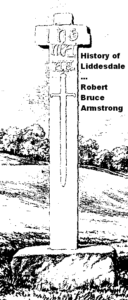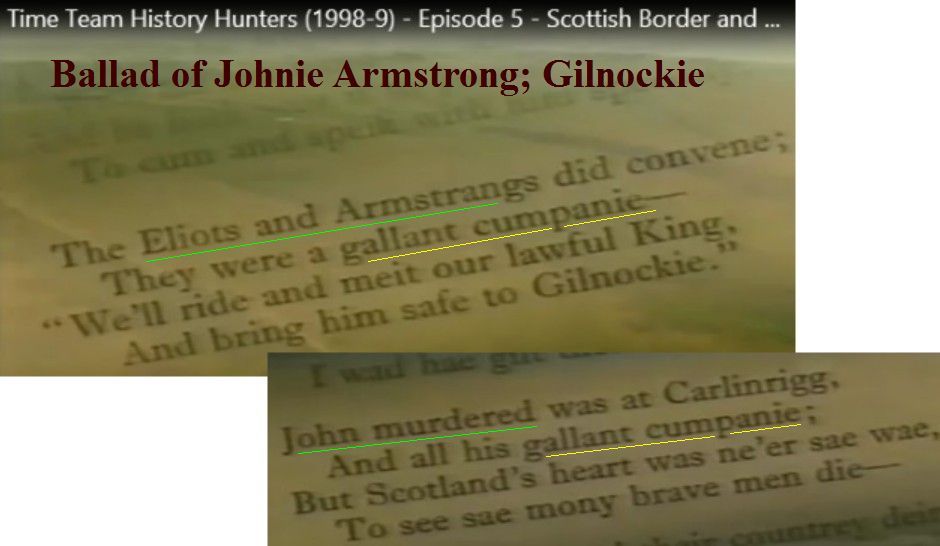above 11/3/2018
recent additions 10/1&2/2018 MSE
HYH Gilnockie Tower July 2018 (PDF newsletter)
Gilnockie’s Hollows Tower;
The Elwalds and Armstrangs did convene;
They were a gallant companie—
“We‘ll ride and meit our lawful king,
And bring him safe to Gilnockie.”
Armstrong Clan UK
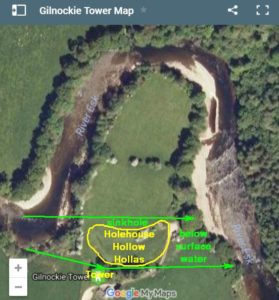
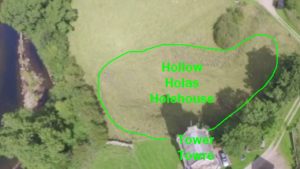
Note;
GILNOCKIE TOWER IS NOW OPEN.
No appointments required.
1 November – 31 March 2018 DAILY 11-3 pm
Closed Christmas Day, Boxing Day and New Year’s Day.
Admission:
Adults £5
Concessions £4
Child (5-16) £2.50
Under 5 Free
if further information is required email arm.clan@sky.com
http://www.armstrongclan.info/gilnockie-tower.html
Lori Watson – Johnnie Armstrang
Johnnie Armstrang
SOME speikis of lords, some speikis of lairds,
And sic lyke men of hie degrie;
Of a gentleman I sing a sang,
Sum tyme called laird of Gilnockie.
The king he wrytes a luving letter,
With his ain hand sae tenderly,
And he hath sent it to Johnie Armstrang,
To cum and speik with him speedily.
The Elliots and Armstrangs did convene;
They were a gallant companie—
“We‘ll ride and meit our lawful king,
And bring him safe to Gilnockie.”
When Johnie cam’ before the king,
Wi’ a’ his men, sae brave to see,
The king he move his bonnet to him;
He ween’d he was a king as well as he.
“May I find grace, my sovereign liege,
Grace for my loyal men and me?
For my name it is Johnie Armstrang,
And subject of yours, my liege,” said he.
“Away, away, thou traitor strang!
Out o’ my sight soon mayst thou be!
I grantit nevir a traitor’s life,
And now I‘ll not begin with thee.”
“To seik het water beneith cauld ice,
Surely it is a greit folie—
I have asked grace at a graceless face,
But there is nane for my men and me!”
“But had I kenn’d ere I cam frae hame,
How thou unkind wadst been to me!
I wad have keepit the Border side,
In spite of all thy force and thee.”
“John murder’d was hung at Carlinrigg,
And all his gallant companie;
But Scotland’s heart was ne’er sae wae,
To see sae mony brave men dee—”
Hollows Tower ca 1883 ink drawing from Gilnockie Castle (Gardens).
An early photo from 1897.

Tower stays about the same in 1965 and in colour with roof 2010.
Photo from 1897 Gilnockie-Hollows Tower similar to 1883 ink drawing.
Gilnockie Castle (Garden);
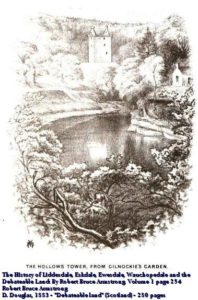
As in the Robert Bruce Armstrong ink drawing, Gilnockie Castle is also referred to as ‘Gilnockies Garden’ (image repeated for comparison).
THE HOLLOWS TOWER, FROM GILNOCKIE’S GARDEN
Given the view angle it shows RB Armstrong’s ink drawing to be rather accurate.
The History of Liddesdale, Eskdale, Ewesdale, Wauchopedale and the Debateable Land: By Robert Bruce Armstrong, Volume 1 page 254
Robert Bruce Armstrong
D. Douglas, 1883 – “Debateable land” (Scotland) – 280 pages
Shows Gilnockie Tower (note; shows another tower, but not at Gilnockie Castle-Garden site, so it is not the castle)
Gilnockie known as Johnnie Armstrong.
Above map seems to show a tower called Gilnockie, where the location is different than but close to Gilnockie Castle-Garden so it is felt that this could bring about this confusion insertion;
http://fred.eu5.org/history-hunters/bomeg.html
Johnie Armstrong, and gallant company of Armstrong and Elliot, grave at Carlinrigg (6/11/2018).
Location of Johnie Armstrong; Gilnockie’s and all his gallant company of Armstrong and Elliot a grave;
Johnie Armstrong, and gallant company of Armstrong and Elliot, grave at Carlinrigg (Carlenrig) (6/11/2018 MSE).
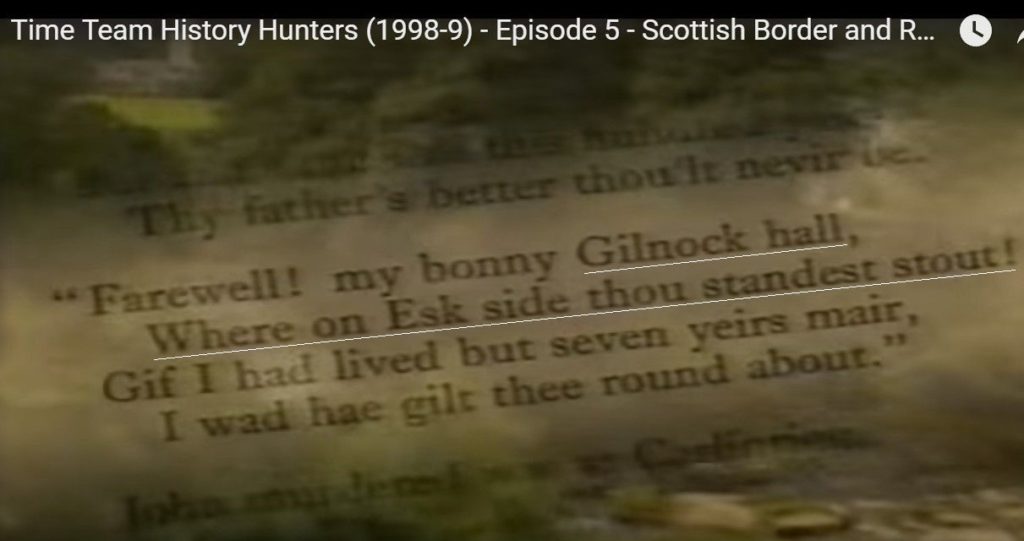

Gilnockie Castle pillar marker;
Canmore-Gilnockie Castle
Geography; Gilnockie Tower
by Armstrong, James Lewis Published 1902
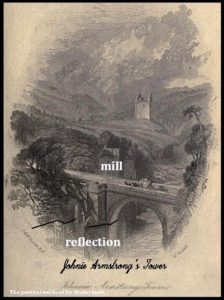
The site now known as Gilnockie Castle lies near Canonbie at the east end of Gilnockie Bridge, which crosses the Esk in Hollows, just 500 m to the south east (NY386782). Today, only an earthwork remains, and there is some doubt as to whether a tower stood there, although it is possible that the earlier tower destroyed in 1528 was located there. It is associated with Johnnie Armstrong, Laird of Gilnockie.
7/22/2016 MSE
Links;
Gilnockie Tower was originally known as Hollows
Hollows or Gilnockie Tower
Canmore; Gilnockie Tower
Associated Castles; Hollows Tower
Scottish Places; Gilnockie (Hollows) Tower
Border Reiver History Hollows Tower
Gilnockie Tower Hollows Canonbie
7/22/2016 MSE
Gilnockie’s Castle;
Leading to;
Johnie Armstrong’s Last Goodnight.
But when John he went from Giltknock-hall,
the wind it blew hard, & full fast it did rain,
Now fare thee well thou Giltknock-hall,
I fear I shall never see thee again.
At Gilnockie Castle (Garden);
Gilnockie Castle 1784 on rock encomppassed by the water of Esk.
Gilnockie castle surrounded by Esk at Hollows.
Response;
To Bill, Gilnockie is a “Phantom Castle,..
7/23/2016 MSE
Gilnockie Castle (Hall & Gardens);
It is felt that now Gilnockie Hall, is in reference to Johnie Armstrong’s Tower at Gilnockie 8/18/2016
John Armstrong the chieftains castle referred to as; Gilnockie’s Garden, where a ruins to and older castle is, and also referred to Gilnockie’s Castle, since both are in the vicinity of Gilnockie Tower of Gilnockie. It is like he acquired a nearby castle in ruins, which he used stone from likely the hall of this castle to build a tower at Gilnockie (gilknocky geological locality) .
The Granite Monthly – Volume 8 – Page 191
Likely location of Gilnockie’s Castle-Garden;
note; and old castle ruins owned by Gilnockie, and turned into his garden.
Motte and bailey castles were in ruins at the time of Johnie Armstrong.
Coming to a conclusion that Gilnockie’s Garden, given RB Armstrong’s drawing has to be down on the River Esk, and Gilnockie’s Castle a ruins supplied building stone for Gilnockie’s tower at Gilnockie, rebuilt at Hollows, and Gilnockie Bridge, east end near where Gilnockie Castle is marked on most maps.
Note; mill and mill dam built after Gilnockie Castle.
Localities for mills are picked where on can obtain the greatest drop, to get the greatest amount of power to operate the mill. Though the river may drop the land beside the river may not creating a high bank or cleft. added MSE 9/12/2016
Likely in the past the water level was high, and therefore the locality was surrounded by water (motted). With the stone being utilized in Gilnockie Tower and an early bridge, there were likely very few stones left at the locality. . Over five hundred years, of flooding know remnants of Gilnockie’s Castle-Garden-Hall-Mansion would likely not be left at locality.
7/25/2016 MSE rewrite 8/18/2016
The castle at Gilnockie has a natural geological mote in the water of the Esk. rewrite 8/18/2016
Motted on the Liddel Water;
Should be noted when Holehouse Tower.
Liddel Strength (The Mote/Moat) south of Gilnockie-Hollows Tower.
Liddel Castle near Castleton formally named Castle Town, but after a New Castleton-Newcastleton appeared Castleton became Old Castleton.
It is indirectly from Liddel Castle, with Castle Town, likely built to the east with stone from the ruins which the parish of Castleto(w)n Parish of Liddesdale acquires its name.
On the Hermitage;
Hermitage Castle on the Hermitage Water has a motte.
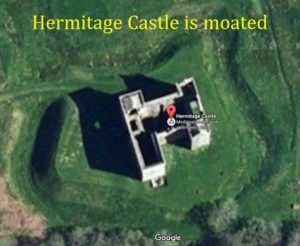
7/25/2016 MSE
Naming Sequence;
Castle and old mote and bailey; to become known as Gilnockie’s Castle, but since it was in ruins at the time of Johnie Armstrong of Gilnockie, it is more appropriately, called Gilnockie’s Garden (RB Armstrong). Stone from the castle was used to build a tower at a geological locality, called gilknocky; high on a bank and bordered by the river Esk and a ravine. So the tower built out of castle stone, at Gilnockie was referred to as Gilnockie Tower, and from his estate at Gilnockie, Johnie Armstrong obtained the name Gilnockie. His Gilnockie tower was destroyed, so Gilnockie rebuilt at a place near a hollow/sink-hole, and this was called Hollows, Hollas, and Holehouse Tower. Hollas, a form of hollow, hole, and also likely moved from the borders to Kentucky, Tennessee, southern Indiana, where the word hollar is a rounded out valley. Since the tower belonged at first to Gilnockie, it was known as Gilnockie’s Tower, which became Gilnockie Tower, since the original at the Gilnockie locality no longer existed.
Soldier Hollow; Nordic cross country skiing venue during Utah, USA olympics;
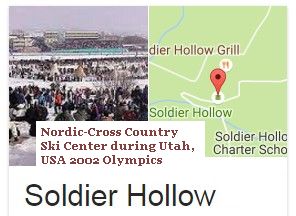
Hollow likely meaning a hollowed (out) region or hole.
The Esk was dammed for a mill, and the fortified entry of the castle was used to build Gilnockie Bridge (corrective rewrite 8/18/2016).
The Dumfriesshire Companion Haig Gordon
The alternative argument is that this really is Hollows and that the original Gilnockie (motted castle) was an earlier structure on the other side of the river. Nigel Tranter, the great chronicler of Scotland’s fortified houses, is adamant: ‘This building is sometimes mistakenly called Gilnockie Tower (unmotted rectangular), the foundations of which in fact survive not far away.’ Whatever its correct name may be, the tower is associated with the notorious gang leader Johnnie Armstrong whose reign of terror throughout the Debatable Land was finally and brutally ended in 1530 by the personal armed intervention of King James V.
Nigel Tranter, makes a good point, and it is felt it the foundations of the original Gilnockie Tower exist they should be searched out an found. The geological locality of gilnockie may be a place to start.
On the map;

Map is from a highly reputable resource the Hawick Archaeological Society of 1923
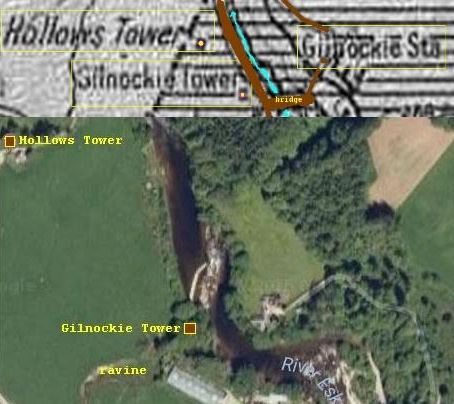
There is a Gilnockie Tower which Nigel Tranter could be referring to, not east, or in the Esk where Gilnockie Castle is located near, and could have foundations as shown on map of Gilnockie Tower, nearyby Hollows Tower. Though the map shows a Hollows and Gilnockie Tower, it is felt the placement on the map, is a approximation.
Nigel Tranter, the great chronicler of Scotland’s fortified houses, is adamant: ‘This building is sometimes mistakenly called Gilnockie Tower, the foundations of which in fact survive not far away.’
7/25/2016 MSE
Tentative Conclusion;
Needs added and on ground research;
Gilnockie Castle once stood upon a rock, encompassed by water, and on the east side of the River Esk, at what is now Hollows.
On the west side of the River Esk an orignal tower was built by Johnie Armstrong known as Gilnockie. The tower was known as Gilnockie’s Tower or just plain Gilnockie Tower.
Map; Hawick Archeological Society of 1923.
The original tower of Gilnockie on west bank of Esk, was destroyed and he built another one using stone from the previous tower to the north, near a hollow/hole in the ground. Newer tower at this hollow, since the older one was no longer there but by foundations, which needs verification was know as Gilnockie’s tower or just Gilnockie Tower.
Text may indicate older stone then the Gilnockie-Hollows structure was used in rebuild; It should be noted the newer tower at Hollows was first own by and called Gilnockie’s Tower or Gilnockie Tower.
Since it is felt the stone from the ruins of an old mote and bailey castle in the river esk, was used to build a tower on the west bank of the Esk next to a ravine at a place called Gilnockie (Gilknocky), and this stone was reused to build Gilnockie’s Tower at the hollow (hollas)/hole, it would be interesting to figure out the date of the spiral ornamentation on the door sill.
As one can see the stone has been worn since the nineteenth century drawing in RB Armstong’s in his History of Liddesdale.
To responding to;
Nigel Tranter, the great chronicler of Scotland’s fortified houses, is adamant: ‘This building is sometimes mistakenly called Gilnockie Tower, the foundations of which in fact survive not far away.’
In response to above; It is felt that from the original Gilnockie Tower, could have been easily destroyed in battle, but the stone where still good and removed to build a replacement Gilnockie Tower at Hollows (at a hollow).
Hollows, old spelling, is hollas, is a hole as in Holehouse.
As one can see publications from 1812 to 1906 the tower which is referred to as Hollows-Gilnockie is being referred to as Holehouse Tower;
(also a reference to Hollows, and Gilnockie’s Garden is made)
Internet Archive BookReader – Chronicles of the Armstrongs;. The BookReader requires … by Armstrong, James Lewis. Published 1902. Topics Armstrong family.
It is felt after Gillknocky Tower (Hall) burned a tower was built by Gilnockie at a sink-hole called a hollow/hollas;
Border Reivers from the 13th to the 17th centuries. A history-Hollows Tower
It is probable that John Armstrong moved from Liddesdale to Eskdale sometime early in the sixteenth century. It is almost certain that Hollows Tower, just south of Langholm, was built between 1525 and 1528, probably in 1526. Johnnie Armstrong was the brother of Thomas Armstrong of Mangerton, Laird of Mangerton, chief of the..
It is felt that Gilnockie Castle (Hall) on a rock in the east side of the River Esk is a wooden motte and bailey castle, as opposed to a stone tower and that is why it could burn. Likely why stones towers where build by Johnie Armstorng called Gilnockie because the stone tower would not burn.
Example of parts of a motte and bailey castle the door being of stone was one of them. So it is felt the door of Gilnockie Castle (Hall) likely survived the fire and was used in Gilnockie Bridge. Though today’s Gilnockie Bridge is likely updated, and this stone may not of been retained for use in it.
Example of ruins of motte and bailey castle. As one can see the parts most likely wood did not survive.
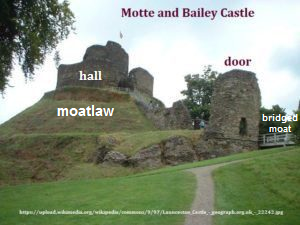
It is felt after Gilnockie Castle was gone and a tower was used by Gilnockie, this region of the castle ruins was referred to as Gilnockie’s Garden. The rock to build Gilnockie Tower is thought to be taken from the hall of the ruins, which would be nearer the west bank which Gilnockie Tower at Gilnockie was first built. This is why it is felt that Gilnockie Tower at Gilnockie geological formation is referred to as Gilnockie’s Hall. The fortification stone for the door on the east, because less river to cross, was left after Gilnockie Tower at Gilnockie was built left over rock of the east castle entrance was used to build Gilnockie Bridge. . Remnants of the rock of the old castle ruins for the entry on the east side may still exist on the east bank of the Esk, making one think that this was the old location of the main castle. 8/19/2016
Holhous (Holehouse) known today as Hollows-Gilnockie Tower of 1597 is the stone tower which stood in 1597.
7/26/2016 MSE
It is still felt the name of the latter built mill Hollows Mill was influenced by Hollows Tower.
With just the foundations of Gilnockie Tower the only thing left (in question, need site examination) of the first tower west of his castle on the Esk and south of Hollows also known as Hollas and Holehouse Tower, now became known as Gilnockie Tower; felt rock used to rebuild this tower was taken from the original Gilnockie tower at the geological formation of gilknockie.
As shown by GBnames census mapped 1881 surname distribution; Hollas is interchangeable with Hollows, as a surname. Region of Hollas Tower, Hollas and Hollows, can be considered old Nothumbria, which excesses during the time of surname adoption.
1590 map predates Blaeu 1654 map.
8/2/2016
many corrections and editing made 8/11/2016 MSE, likely more changes to come.
Writer at this date; 8/14/2016, feels that the stone in older structures of Gilnockie Castle after burning, and Gilnockie Tower not the one having been call Hollas, Hollows, and Holehouse, but is located.
It is felt there was a Gilnockie Castle on an island in the River Esk, and a Gilnockie Tower along the ravine which do not exist today, but a Hollows-Gilnockie Tower does.
http://www.electricscotland.com/history/gazetteer/vol3page87.htm
Gilnocky Tower at Hollows;
It is felt that engravings of 1813, were done more to attract tourists than for documentary accuracy, like that of Robert Bruce Armstrong.
Border Antiquities of England & Scotland, Volume 1 Longman & Company, 1813
Gilnockie Castle, which then stood upon a rock, encompassed by the water of Esk, Poetical Museum, Hawick 1784
8/15/2016 MSE
Correction (8/17/2016)
Location of gealogical features of hollows and gilknocky.
hollows;
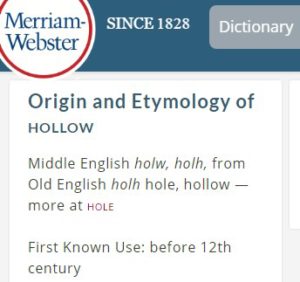
hollows;
Holehouse (Hollows), has hard blue inelastic low porosity limestone on top, and below a pores sandstone, clay which can easily be washed away creating a subterranean channel cutting through the meander, causing a hollows (sink-hole), where Hollows Tower;
The hollow, 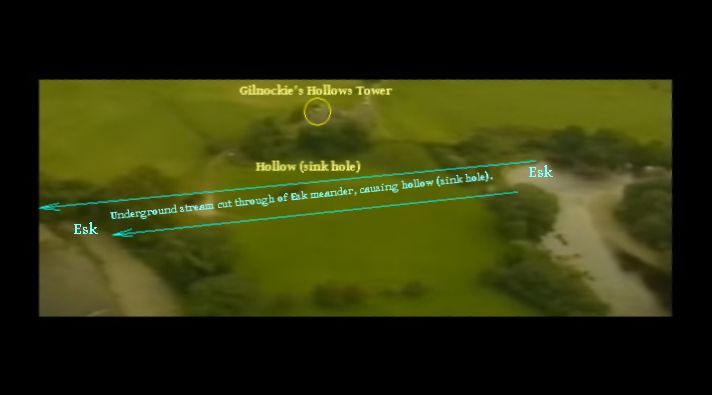 sink-hole, gave easier access to blue limestone rock strata which would be quarried, and added to the tower. May need closer look to verify tower is limestone, because it could be sandstone or both.
sink-hole, gave easier access to blue limestone rock strata which would be quarried, and added to the tower. May need closer look to verify tower is limestone, because it could be sandstone or both.
The hole/hollow was quarried; it’s shape is not oval like a regular quarry, but is shaped like the out edges of a sink-hole have been quarried.
Gilnockie Tower column;
Greenknowe Tower having a distinctive red-orange, ferrous oxidated sandstone in it’s architecture, quite distinctive from the white limestone, showing similar features of Gilknokie’s Tower at Hollows, but with a lot more sandstone in its construction.
Greenknowe Tower, Scottish borders, seen from the south-west.
For the corner stone on Gilnockie’s Hollows Tower, limestone was used on the tower. Given the higher compression strength but harder to cut, one can observe by shape an colouration, there is more limestone in the lower part of the tower than the upper part. So it is felt that stone was quarried from the hollow which is at first a sink hole of fractured limestone around its perimeter. to build Gilnockie’s Tower the hollow.
After the limestone had been quarried it did not retained its appearance as a hollow, and was referred there after as a quarry.
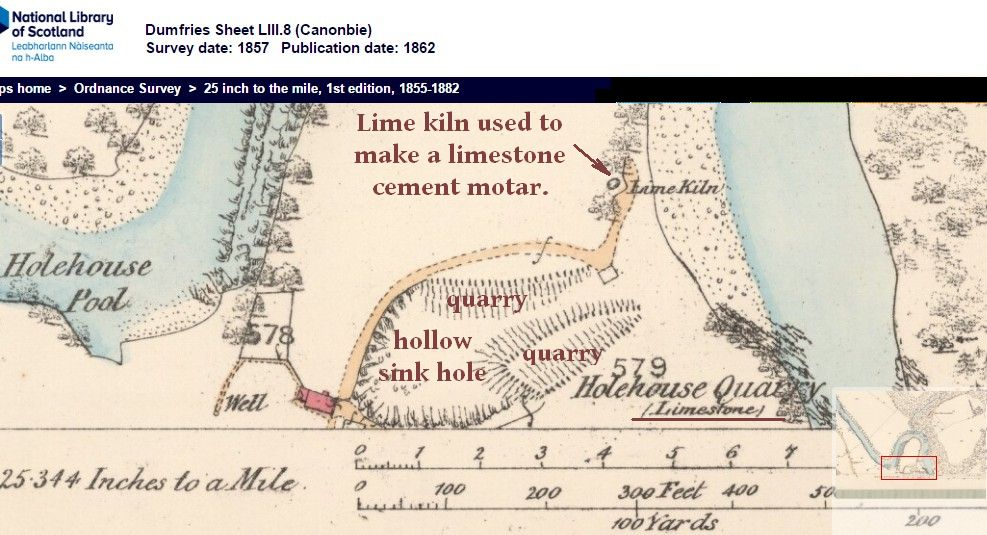
In the above map there is a well. It takes a lot work to have a deep well, but in this case the well water is at the level of the water in the river, which is a very short distance down. This can be easily tested by drilling a new well and measuring the water level in it.
Map shows quarry separate from hollow (sink-hole).
The quarried limestone was put into the kiln as shown on map above to make a cement mortar.
Holehouse is;
MORTAR;
Gilnocky built his first tower on a gill-knock next to a ravine from a hall (tower) on a moatlaw (mound in the moat), where the hall of the ruins of the castle he owned was at. Since no mortar was used in the construction, and it was just stacked limestone like the Hermitage Castle of today is, more wood was utilized in the construction, and the hall of the ruins of the castle elevated to a gill-knock and high horizon, next to a ravine and cleft.
With a nearby sink-hole a hollow, where the karstic, enviroment, with the subsurface hydrology, cutting through underlying, softer strata, in the meandering River Esk, much in a manner an ox bow is created and with four inches of this sedimentary strata being coal, in order to have a strong tower, from which Johnnie Armstrong, acquired his name Gilnockie, decided to have mortar utilized for his new place of residence referred to as a, a hollow, or a hollas, a form of the word hollar, which border people brought the the Appalachian Mountains of the southern United States, meaning a hollowed out valley.
Having the availability, of a four inch coal seam, and a high grade blue limestone, Gilknockie, was able to make, by kilning it to the temperature at which cement is made, a mortar used in the construction of his tower at the hollow. This meant for a stronger tower which would last through the ages without burning.
Once Johnnie Armstrong, Gilnockie, put mortar in the construction his tower at the hollow (sink-hole), it made the stone difficult to break away, and therefore reuse, and that would give good reason, besides not in use during the time of The Union is was not destroyed and left standing.
Croyser (Crozier/Crosser), tower at O.(Over) Riccarton, near O.&N. (Over and Nether/under) Larriston of Robert Ellot of Redheugh and Larriston, and of brother Martin of Redheugh-Braidley, and Prickenhaugh.
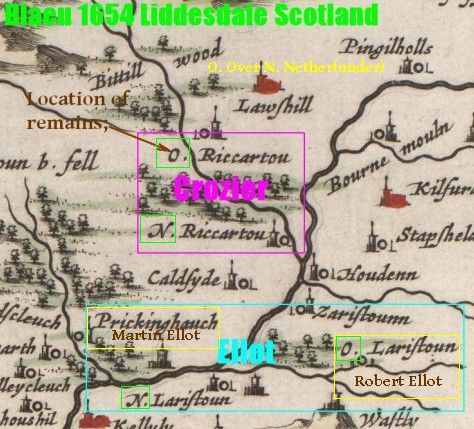
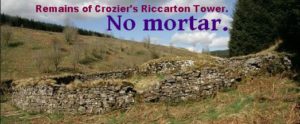
Having no mortar, made it easy to tear down at time of The Union, but Johnnie Armstrong’s Gilnockie Tower at Hollows, mortar gave it extra strength to survive.
MSE 9/7&9/2016, and 11/5/2016
Correction (7/28/2016); Though Hollows is as surname, but vary rare especially in the region. It is felt that the name Hollows came from the hollow, concave in the River Esk in which the mill was built into.
Map indicates hollowed out region in ground next to Hollows Tower;
above 6/6/2016 MSE
The meanders carving the Esk like a vise on the tower, but the fracture or softer, surfaced blue limestone strata in near the tower, could not hold itself when and underground stream, cut through the clay strata, the upper part sunk, creating an unique feature in the region a hollow (sink-hole).
gilknocky;
(correction 8/17/2016)

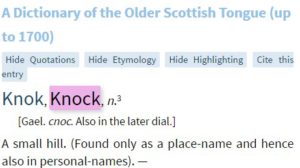
MAP;
Above map shows location of two different towers; One called Gilnockie, the other called Hollows.
Earlier names since;
Gilnockie Tower is close to ravine.
http://www.electricscotland.com/history/gazetteer/vol3page271.htm
Above; The Border peel-tower of Gilnockie stood on a small promontory, washed on three sides by the river Esk, so steep, and rocky as to be scarcely accessible except on the land side, and defended there by a deep ditch.
Likely, no remnants of tower at locality since a sluice for the mill went through there;
Above gives Gilnockie Tower on the river bank, and the castle near the bridge. added 8/16/2016
8/14/2016 MSE
Overview;
8/17/2016 MSE
Note; It is felt that the castle previous to Gilnockie’s Garden, was previous to Gilnockie. Remnants of the fortification around the door were used to build Gilnockie Bridge.
8/17/2016
Conclusion with refinement;
It is felt that there was a castle on a natural geological mote with stone left in the river Esk, with a fortified entry door facing east, at the time of Johnie Armstrong. This was more appropriately called Gilnockie’s Garden. What was referred to as Gilnockie’s castle was in ruins with stone left at location. It should be noted, that though The Hermitage Castle was in use at the time, is not a mote and bailey, like it’s predecessors along the Liddel Water of Liddel Strength or Liddel Castle.
From the stone of this castle’s hall, Johnie Armstrong built a tower referred to as Gilnockie Tower or Hall, on a high bank on the west side bordered by a ravine and river Esk on three sides. This is the geological region; gilknocky, which Johnie Armstrong of Gilnockie, received his name Gilnockie. Then this tower was destroyed, and this rock was used to build a new tower, at geological region of hollows. Hollows Tower was a rebuilt from the tower at Gilnockie by Johnie Armstrong called Gilnockie. So Hollows Tower belonging to Gilnockie, was known as Gilnockie’s Tower or just Gilnockie Tower, since the tower at Gilnockie, may only existed as much as foundation only.
Armstrongs of Liddesdale.
The stone of the fortified door on the east entry of the Castle ruins, which was left after building the nearby tower at Gilnockie next to a ravine and on the bank of the river Esk, was used to build Gilnockie Bridge.
8/17-19/2016
Likely future additions, cuts, and corrections. MSE
Johnnie Armstrong is felt to bring about the name Armstrong;
Alexandir Armystrand 1376 was the first recorded in Liddesdale, likely the father of AAII first recorded on Milnholm cross, and buried there in a Christain IHS burial.
Armystrand, meant an armystrand of towers along the Liddel Water, then in 154o it was recorded as Armistrang, which representing about two thirds of the pre Union border army they the Armistrang were the strong army.
Johnnie Armstrong used a seal with an arm on it;
That brought about the Armstrong of Liddel Water as being called Armstrong.
The shield with arms on it was added to the top of the Milnholme (IHS burial cross near a mill on a large flat bank in which the two of Newcastleton, Scotland now lies) later part of 19th century.
Another inking in Robert Bruce Armstrong’s, History of Liddesdale…
AAII of Alexandir Armystrand II, who was buried young, it is felt after his wife a name which was from a Scandinavian (shown by Scandinavian broad sword) form of Margaret, was buried beside him, commonly used today among Border descendants one marker for both the wife and husband. So the inscription was changed from AAII to MA AA.
The signature Johnnie Armstrong arm is used for a plaque at his grave site.
Fiona Armstrong on Johnnie Armstrong, Armstrong Clan BBC;
In; 2017 series of Border Life, presented by Fiona Armstrong.
Video with renovations of two towers, highlighting, Gilknockie.
Y-DNA, the Fairbairn, are high in I-M253, Where the Armstrong and Little have a high portion of Fairbairn I-M253. It should be noted it is felt followers of Fairbairn, along the Liddel Water, took their surname Little/Liddel from the Liddel Water, and from being army strand, army strong, along the Liddel Water, and the Fairbairn in the east borders not along the Liddel took the name of their ancestor Fairbairn which likely carried I-M253.
8/20/2016 MSE
Email to Robert Armstrong of the University of St. Andrews;
Robert Armstrong, (edited a bit for clarification)
Border-Reiver-History-Hollows-Tower-in-the-Debateable-Land;
Though today it is called Hollows, its former names were Hollas and Holehouse ((hollow, hollas, and hole similar in meaning for give dates and localities). There is clear evidence on its eastern side (the one which backs on to the Esk) that the stone to construct the tower was hewn from the ground there with the result that there is a almost vertical incline behind which would add greatly to its defence in any raid from the river side. There is a possibility that ‘Holehouse’ was a fitting name given the massive man-made hole that resulted from the mining of the stone. added by MSE 9/22/2016
Felt there is a subsurface, soft strata cut through of the meander in a manner in which an oxbow would be created making for a pre-quarried sink hole.
Many people surmise that this tower replaced a former one known as ‘Gilnockie’ though evidence is sparse. Just to the south of Hollows, on a promontory above the river Esk which must frame one of the most beautiful sights to be seen in the Scottish Borders, there is a natural defensive platform which shows outlines of some earthwork. This is the supposed site of Gilnockie. A small and simple plaque has been erected in recent times to commemorate the spot.
Michael Martin Murphey
If he does not sound like a border singer, he lives in New Mexico, and sometimes Texas,USA. Has written the State of New Mexico’s ballad; what we are known as Land of Enchantment. Have heard him sing is at the Santa Fe, New Mexico Opera house, and Red Rock Park, Gallup, New Mexico.
Guess this is what happens to a border song when you have been away for centuries;
10/25/2016 MSE
Have You Heard?
About the Anglo-Scottish Border
Issue Sixty-four June/July 2017
The season has started well for Gilnockie Tower, even taking into account the sign at the end of the tower entrance road indicating that the building is “Closed”. By chatting with our budding visitors, we suspect that the majority of people who have driven up the driveway just want to have a ‘cheeky wee keek’ at the building while visiting the Esk Valley area. No doubt they were drawn in by the numerous tradesmen’s vehicles parked by the side of the tower.
If you were one of these visitors, then please accept our sincere apologies that we could not let you witness the changes in all of the rooms within the tower. Boring old health and safety regulations stopped us.
We have many visitors who arrive at the tower searching for kin folks, and they have little they can tell us about the people or places they are researching … other than they did have a relative who lived in the Debatable Lands many, many years ago. We are preparing an explanation document to help describe that process. To initially help us help you: Research weel afore ee sie oos wi the richt hoose, richt dauts, richt sowel, an’ t’en we’el dae whit wi kin tae help ee oot!
Converted into a more common Border dialect: Research well before you meet with us, preferably as near to the correct place, correct dates, and correct person as you can, and then we will do what we can to help you out. Our team want to help the budding historians, so help us and we will endeavour to help you.
From the Tower –
This month, folks, the tower has tested the numerous artisans working in the building at Gilnockie. Having said that, the tower repair work now is coming to an end, with many of the finishing touches being put in place by carpenters, electricians, stone masons and other trades working on site. It is our intention to go into detail, giving you a blow by blow story about what exactly went on. Regretfully, time has caught up with us this last two months, but the tale will be told over the next few months.
All that said, a wee romantic story before we go any further. This one brings tears to my eyes. A few months ago we invited the local fire brigade into the tower to clarify the fire protection needs for the inside of the building. Mike, the fire officer from the Dumfries Fire Station, and I were discussing fire prevention strategy for the first floor of the building when this young man came huffing and puffing up the tower spiral staircase entering into the first floor room, red in the face. “Excuse me,” says I, “can we help?” “Yes!” says our man, “I would love to propose to my girl in front of the Gilnockie Tower Great Hall fire place, if that was in order?” Mike and I looked at each other and in unison said, “Aye Lad, be our guest.”
A few moments later the guy and his elegant lady arrived back, obviously she was not interested in old castles, nor had she any knowledge of what was about to happen. Manoeuvring the lady up to the stone fire place our man gets down on one knee and proposes delicately, lovingly and reverently, looking deep into her eyes. Silence, absolute silence in the room for what seemed like a Millennium, then, with a tear and a simple “Yes,” he swept her into his arms. The official onsite photographers, the fire officer and I recorded the entire event on the couple’s i-Phone.
Regretfully the affair went so quickly we did not get any details other than the number on the back of the black Porsche 911 driving up the roadway and away from the tower. If anyone knows more about this story, please do be so kind as to let us know the final outcome.
We’ll tell you much more about the tower repairs shortly, other than that the decorators have arrived this morning! Getting our ‘Lady of the Esk Valley into an operable condition is our priority.
From The Reiver Trail 60 –
The Reiver Trail 60 has been a part of our Border Reiver tour experience for over 20 years, but alas it is reaching a time in its life where tender loving care is required. We have set up a group who will look at how we can inject more information along with more interest into the experience, but this will take time.
The Reiver Trail as it is at the moment takes the visitor back to the days when their forefathers were part of the Debatable Lands between England and Scotland. Definitely, we’ll say more on this extremely interesting subject as travel we through our HYH journey.
A Grave Situation!
The theft of the land around the Johnnie Armstrong grave at Teviothead remains an ongoing problem, with little help from our politicians, either local or National. Again it is our intention to go deep into the root cause of this problem, with the hope that some of the recipients of this newsletter can help us raise the roof at Holyrood, Edinburgh and start the recovery process of the land at Teviothead. We’ll have much more on that subject as we develop this newsletter.
Roger O. LaPointe, Staff Writer, with the Sentinel-Tribune (Bowling Green, Ohio) published the rather interesting and attached article “Tartan’s tale weaves together BG man, Neil Armstrong, piece of history lands at Ohio History Connection after 45 years, on the 3rd July 2017”. Part of the content relates to the Neil Armstrong Lunar or Moon tartan produced in the town of Langholm, the textile town 6 miles to the north of Gilnockie Tower.
Dyeing or colouring the woollen yarn to the designer’s specific colours and woven by a local factory known as the ‘Mill on the Hill’ on the outskirts of the town, this beautiful tartan was a great success during the time Armstrong made history on another sphere in space. Ian Maxwell was the factory owner at the time and tartan designer named the tartan The Moon Tartan and The Lunar Tartan made in Armstrong’s honour, to celebrate his journey and landing on the moon’s surface, and of course his visit to the Muckle Toon o’ Langholm.
If you view the International Tartan Index it records that “The black, brown and grey were from the lunar rock brought back to earth by the Apollo flights, and the red was for the rocket flame.” A sample length of the cloth is still held in the Clan Armstrong Trust archive and can be viewed upon request.
Below is a link you can use to check out the Sentinel-Tribune on-line version of this story, and a photo of the tartan can be viewed.
The author apologies for the length of this HYH. Pressures developed by the ‘Lady of the Valley’ have taken him away from the HYH document content, but this next month, August 2017 we can get into the real story of the Anglo-Scottish Border Esk Valley.
There are only a couple of pages in this issue. So for the readers who have mentioned in their communications with me that their coffee had gone cold by the time they had read the content in issue 63, I await your comments on these pages with interest.
Our grateful and everlasting thank you to those who help us, Thank you.
Aye tae ee a’,
IanM.
Gilnockie Tower will open as a Visitor Centre very shortly.
Connect us on gilnockietower@gmail.com and Mobile/Cell Phone: 07733 065587
8/6/2017 MSE
http://www.elwald.com/hermitage-castles-infinis-windy-edge/

